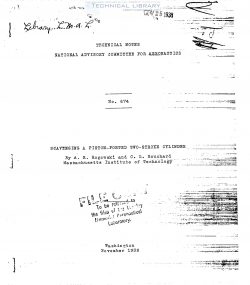naca-tn-674
- Version
- 145 Downloads
- 1.94 MB File Size
- 1 File Count
- November 28, 2016 Create Date
- November 28, 2016 Last Updated
National Advisory Committee for Aeronautics, Technical Notes - Scavenging a Piston Ported Two Stroke Cylinder

An investigation was made with a specialIy designed ’-
engine to determine the scavenging charact_er_istics of a '__
large number of inlet—port shapes and arrangements and the
optimum port arrangement and timing for this particular
type of engine. A special cylinder construction permitted
ment of both the inlet and exhaust ports.
The study of the effect of port shape combinations _; -;—
and timings on engine performance was made using illumiJ'" '
nating gas as a fuel. Through variations in inlet—port
arrangement and port timings, the value o.f the scavenging'“___
efficiency was increased from an original 44 percent to
approximately 67 percent with a corresponding increase in
power. With the optimum port arrangement and timing deter—
mined, a large number of performance runs'wGTewfitde”ufider “._m
both spark~ignition and compression—ignition operatiofiimmff ” -~—
With a view toward increasing the specific output and
simplifying the engine construction, much attention and
work is being devoted to the development of suitabIe two—
stroke engines for aircraft use.' Since the output of a ' JJ_ ”—
two~stroke engine is primarily dependent upon the scaveng— m
ing efficiency of- its cylinders, the problem of success~';:__“‘——“
fully developing an engine of this type is mainly one of_ m
obtaining the most complete scavenging possible without
the use of a complicated mechanism or of excessively high
scavenging pressures.
There are two general methods of scavenging the cylin~
der of t-he two—stroke engine, namely, the "through" scav-
enging in which inlet and exhaust ports are at opposite
ends of the cylinder and the "loop” scavenging where inlet
and exhaust ports are at the same end of the cylinder. The
scavenging patterns of any two-stroke engine may be clas—
sified under one of these catagories.
The through—scavenged engine necessitates the use of
valve gear or double pistons. This method, however, per—
mite unidirectional flow of the combustion products and of
the scavenging air through the cylinder. The loop~scav—
enged engine, on the contrary, requires neither valve gear
nor double pistons. It is necessary to scavenge this type
of cylinder by circulating the air in the form of a loop'
and, consequently, the scavenging air is much more likely
to mix with the burned gases, making it more difficult to
secure high scavenging efficiency.
| File | Action |
|---|---|
| naca-tn-674 Scavenging a Piston Ported Two Stroke Cylinder.pdf | Download |

Comment On This Post